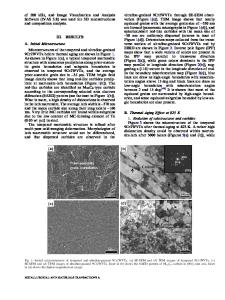Microstructural evolution and thermal stability
- PDF / 2,556,352 Bytes
- 9 Pages / 597 x 774 pts Page_size
- 24 Downloads / 344 Views
I.
INTRODUCTION
THE copper-niobium alloy system has been of considerable interest as a basis for fabrication of superconducting materials in the form of cast and drawn fine wires, t~,21 Research on these materials led to the discovery that the Cu-Nb wires exhibited anomalously high strengths, exceeding that predicted by a rule of mixtures analysis. 13,4'5~The extensive mechanical reductions of cast microstructures, characterized by random arrays of niobium dendrites dispersed within a continuous copper matrix, caused the formation of an aligned, filamentary in situ composite. Since the size and spacing of the niobium filaments were dependent on the scale of the original cast microstructure, techniques which could produce an enhanced refinement of the dispersed second phase in the initial solidified microstructure could also lead to improved mechanical properties, f6j However, previous research has also established that the high strength filamentary Cu-Nb composite alloys, 17j as well as Cu-Fe tSI and Cu-Ta, tT~suffer from morphological instabilities when exposed to even moderate temperatures in the range of 600 ~ Thus, improved thermal stability of the strengthening phase is desired. In this study, the rapid solidification of a gas-atomized Cu-21 wt pct Nb-2 wt pct Mo alloy has been used as a method of producing alloy powder particles with finescale, equiaxed microstructures. As will be shown, the microstructural features which characterize the rapidly solidified powder particles can be much different from those in a conventionally cast counterpart. The present study relies in part on the results of Verhoeven and coworkers tgj who observed (a) the appearance of niobiumrich multiphase spheroids in chill cast Cu-15 wt pct Nb
and Cu-20 wt pct Nb alloys which had been contaminated with oxygen and (b) fine Nb-rich spheroids in thin, rapidly quenched, oxygen-free splats (0.5 mm). t6~ The latter observation was attributed to the onset of a metastable monotectic reaction which occurs in Cu-Nb alloys at high solidification rates, while the former observation had been attributed to the formation of a similar, but stable miscibility gap within the Cu-Nb-O ternary system. This suggests that it might be possible to induce a liquid phase separation reaction and subsequently solidify the Nb-rich liquid as discrete spheroids dispersed throughout a Cu-rich matrix. An examination of the copper-niobium equilibrium phase diagram shown in Figure 1 supports this hypothesis; metastable miscibility gaps have been observed to occur in similar systems in which smooth, flat liquidus lines extend over a range of compositions, i11,12.131 The present study utilizes high-pressure gas atomization and the associated rapid solidification as a means of inducing metastable liquid phase separation in a Cu-21 wt pct Nb-2 wt pct Mo alloy of relatively low oxygen content. The microstructural evolution of the atomized alloy powder particles will be shown to depend on panicle size and is analyzed in terms of the influence of atomization and rapid solidi
Data Loading...











